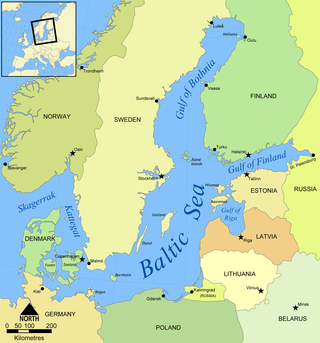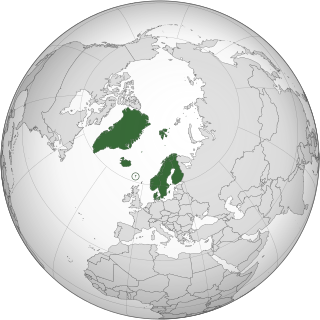
A kantele or kannel is a traditional Finnish and Karelian plucked string instrument (chordophone) belonging to the south east Baltic box zither family known as the Baltic psaltery along with Estonian kannel, Latvian kokles, Lithuanian kanklės and Russian gusli.

Scandinavia is a subregion of Northern Europe, with strong historical, cultural, and linguistic ties between its constituent peoples. Scandinavia most commonly refers to Denmark, Norway, and Sweden. It can sometimes also refer to the Scandinavian Peninsula. In English usage, Scandinavia is sometimes used as a synonym for Nordic countries. Iceland and the Faroe Islands are sometimes included in Scandinavia for their ethnolinguistic relations with Sweden, Norway and Denmark. While Finland differs from other Nordic countries in this respect, some authors call it Scandinavian due to its economic and cultural similarities.

The Nordic Council is the official body for formal inter-parliamentary Nordic cooperation among the Nordic countries. Formed in 1952, it has 87 representatives from Denmark, Finland, Iceland, Norway, and Sweden as well as from the autonomous areas of the Faroe Islands, Greenland, and Åland. The representatives are members of parliament in their respective countries or areas and are elected by those parliaments. The Council holds ordinary sessions each year in October/November and usually one extra session per year with a specific theme. The council's official languages are Danish, Finnish, Icelandic, Norwegian, and Swedish, though it uses only the mutually intelligible Scandinavian languages—Danish, Norwegian, and Swedish—as its working languages. These three comprise the first language of around 80% of the region's population and are learned as a second or foreign language by the remaining 20%.

The northern region of Europe has several definitions. A restrictive definition may describe Northern Europe as being roughly north of the southern coast of the Baltic Sea, which is about 54°N, or may be based on other geographical factors such as climate and ecology.

The terms Baltic Sea Region, Baltic Rim countries, and the Baltic Sea countries/states refer to slightly different combinations of countries in the general area surrounding the Baltic Sea, mainly in Northern Europe. The term "Baltic states" refers specifically to one such grouping.

Estonians or Estonian people are a Baltic Finnic ethnic group who speak the Estonian language. Their nation state is Estonia.
The recorded history of music in Estonia dates back as far as the 12th century.
Traditional Latvian music is often set to traditional poetry called dainas, featuring pre-Christian themes and legends, drone vocal styles and Baltic psaltery.

Gusli is the oldest East Slavic multi-string plucked instrument, belonging to the zither family, due to its strings being parallel to its resonance board. Its roots lie in Veliky Novgorod in Novgorodian Republic. It has its relatives in Europe and throughout the world: kantele in Finland, kannel in Estonia, kanklės in Lithuania, kokles in Latvia, Zither in Germany, citera in the Czech Republic, and psalterium in France. Furthermore, the kanun has been found in Arabic countries, and the autoharp, in the United States. It is also related to such ancient instruments as Chinese gu zheng, which has a thousand-year history, and its Japanese relative koto. A stringed musical instrument called guslim is listed as one of the Me in ancient Sumer.

The kanklės is a Lithuanian plucked string instrument (chordophone) belonging to the Baltic box zither family known as the Baltic psaltery, along with the Latvian kokles, Estonian kannel, Finnish kantele, and Russian gusli.

Gjallarhorn is a Finnish band that performs world music with roots in the folk music of Finland and Sweden. The group was formed in 1994. The band's music echoes the ancient folk music tradition of Scandinavia with medieval ballads, minuets, prayers in runo-metric chanting and ancient Icelandic rímur epics in a modern way. The group is named after the Gjallarhorn associated with the god Heimdallr from the Norse mythology.

Kokle or historically kokles (kūkles) is a Latvian plucked string instrument (chordophone) belonging to the Baltic box zither family known as the Baltic psaltery along with Lithuanian kanklės, Estonian kannel, Finnish kantele, and Russian krylovidnye gusli. The first possible kokles related archaeological findings in the territory of modern Latvia are from the 13th century, while the first reliable written information about kokles playing comes from the beginning of the 17th century. The first known kokles tune was notated in 1891, but the first kokles recordings into gramophone records and movies were made in the 1930s. Both kokles and kokles playing are included in the Latvian Culture Canon.

Kannel is an Estonian plucked string instrument (chordophone) belonging to the Baltic box zither family known as the Baltic psaltery along with Finnish kantele, Latvian kokles, Lithuanian kanklės, and Russian gusli. The Estonian kannel has a variety of traditional tunings. In Estonia, studying the kannel has made a resurgence after some years of decline.

Scandinavian studies is an interdisciplinary academic field of area studies, mainly in the United States and Germany, that primarily focuses on the Scandinavian languages and cultural studies pertaining to Scandinavia and Scandinavian language and culture in the other Nordic countries. While Scandinavia is defined as Denmark, Norway and Sweden, the term Scandinavian in an ethnic, cultural and linguistic sense is often used synonymously with North Germanic and also refers to the peoples and languages of the Faroe Islands and Iceland; furthermore a minority in Finland are ethnically Scandinavian and speak Swedish natively.

The talharpa, also known as a tagelharpa, hiiu kannel or stråkharpa, is a two to four stringed bowed lyre from northern Europe. It is questionable whether it was formerly common and widespread in Scandinavia. Historically, it has been played in the Estonian-Swedish areas and in Western Estonia, particularly among Estonian Swedes who came to Estonia around the 10th century from the Swedish part of Finland; they likely brought the instrument with them It is similar to the Finnish jouhikko and the Welsh crwth. Jouhikko, a close relative of talharpa, is still known in Finland.

The Baltic Finnic peoples, often simply referred to as the Finnic peoples, are the peoples inhabiting the Baltic Sea region in Northern and Eastern Europe who speak Finnic languages. They include the Finns, Estonians, Karelians, Veps, Izhorians, Votes, and Livonians. In some cases the Kvens, Ingrians, Tornedalians and speakers of Meänkieli are considered separate from the Finns.

The Nordic countries are a geographical and cultural region in Northern Europe and the North Atlantic. It includes the sovereign states of Denmark, Finland, Iceland, Norway and Sweden; the autonomous territories of the Faroe Islands and Greenland; and the autonomous region of Åland.

Baltic psaltery is a family of related plucked box zithers, psalteries, historically found in the southeast vicinity of the Baltic Sea and played by the Baltic people, Baltic Finns, Volga Finns and northwestern Russians.

Runic song, also referred to as Rune song, Runo song, or Kalevala song, is a form of oral poetry and national epic historically practiced among the Baltic Finnic peoples. It includes the Finnish epic poems Kalevala and Kanteletar, as well as the Estonian Kalevipoeg.
















